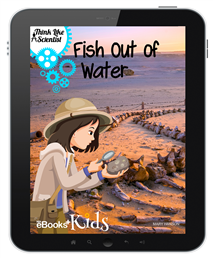E-book Invites Young Readers to Discover How a Fish Fossil Exists in an Egyptian Desert
By Carole Hayward
Posted on 2019-03-06
 After devoting 25 years to the teaching profession, Mary Hanson was seeking “out of the box professional development opportunities.”
After devoting 25 years to the teaching profession, Mary Hanson was seeking “out of the box professional development opportunities.”
“I was at the point in my career where I was looking for (more than) just getting another master’s degree or license,” said Hanson, who teaches fourth grade for the Whitehall (Wisc.) Memorial School District. She applied to participate in a federally-funded grant project that sought to equip elementary school teachers with practical strategies for integrating literacy with the NGSS in their classrooms.
Hanson was accepted into the program (Using Children’s Literature to Teach Science), which was run out of the University of Wisconsin-Stout, and the experience not only expanded her skill, but broadened her professional network. Hanson learned through Shelley Lee, one of the program’s coordinators, that NSTA was seeking new authors to add to its publishing roster.
“Being an author was always something that I wanted to do,” Hanson confessed. “It’s been on my bucket list since I was a kid. So, I looked up more information on the NSTA website, I started sending emails, and there I was, on my way to becoming an author.”
Hanson admits that she initially saw her idea getting published as a “regular book,” but changed her mind after personally experiencing one of NSTA’s eBook+ Kids interactive e-books.
“I realized that this format was not just going to be the process of making my book available online,” she explained. “You have to experience an NSTA eBook+ for Kids to fully understand it. Once I did, I started seeing how I could arrange lessons to support the e-book’s learnings in my classroom, via my Smartboard, via interactives. I told myself, ‘I can do this!’”
Hanson’s interactive e-book, Fish Out of Water, focuses on earth science, a subject she is passionate about and loves teaching.
“It’s mind-blowing thinking about the planet that we are on and what’s literally going on under our feet while we go along with our daily lives,” she said. “Just think of the huge amount of time that the earth has been here and what’s been happening all along! And then think about the short time that humans have been on the planet and how it’s changed ever since. Kids get really excited learning about things they’ve never thought about before.”
Fish Out of Water takes students on an expedition to a paleontological site in the Egyptian dessert. Led by 10-year-old Kat, a student paleontologist, who communicates with her readers via video chat, students will discover just how a fossil fish came to exist in such a dry, arid place; help Kat identify the age of the fossil; and learn how fossils can be used to understand the earth’s surface and how/why it changes over time. Kat’s expedition is like a puzzle, Hanson explained, one that students work to complete as they progress throughout the book.
In compiling her content, the author drew from real-life experiences like the time she took her own sons to visit Yellowstone National Park.
“The water was bubbling up because the crust is thin,” Hanson recalled. “We walked over a bridge that was right over the caldera. We could smell something coming from inside the earth!
“I’ve always had a strong need to understand things, especially the planet. I always want to know more and then share what I learn with others!”
Science, social studies, and writing, three subjects that Hanson enjoys teaching most, were brought together in her e-book, which is specifically written about one, 4th-grade science standards: Code 4 ESS1-1.
Even before the Wisconsin Department of Education formally adopted the NGSS, Hanson said that her rural, progressive school district enthusiastically embraced the standards and set out to revamp its entire science curriculum.
“We’ve been working for a few years in our district on rewriting our curriculum to meet the NGSS, and we think it’s pretty good,” Hanson said. “At first it seems like there is so much: Crossing-cutting concepts, core disciplinary ideas, connections to be made with both literature and math standards. But once you learn how to read the standards and understand how they work, it’s not so bad.”
The writer has another e-book in the works which will be based on an upcoming trip to Iceland.
“My favorite part of earth science is plate tectonics,” Hanson said. “In Iceland, you can see the North American and European tectonic plates pulling apart. Most of the time, this activity occurs underneath the ocean, so you cannot see it. That’s what makes Iceland so special.
“My next book will follow my character Kat to Iceland where she will help her friend Alfred, a student geologist, crack a mysterious case.”
Follow NSTA

